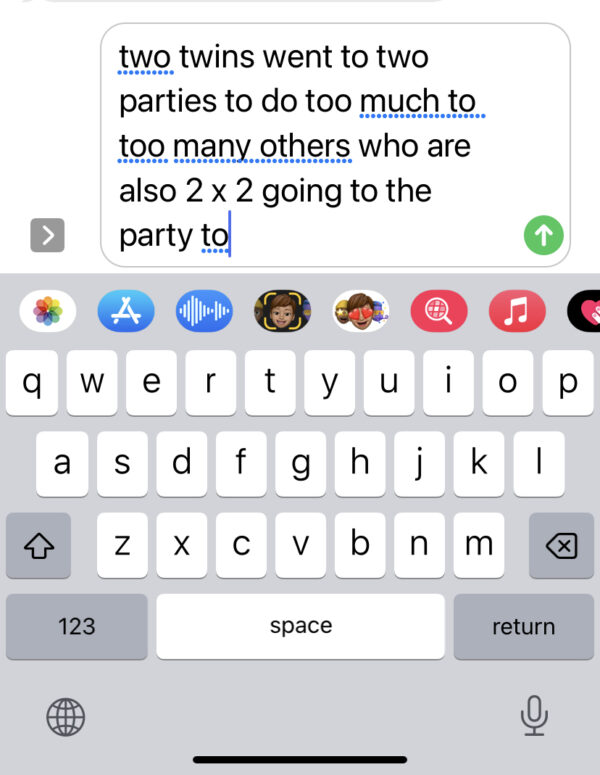
The Perceived Intentionality of AI: A Reflection of Human Influence
The rise of Artificial Intelligence (AI) has brought about transformative changes in the way we interact with technology and information. AI language models, like GPT-3, have become integral in numerous aspects of our lives, from chatbots to content generation. However, a fascinating aspect of these interactions is the perceived intentionality of AI. Despite the fundamental absence of consciousness and intentions in AI, it often appears as if these systems possess specific intentions or leanings. This essay explores this paradox, delving into how the perceptions of AI’s intentionality are shaped by the human influences that underpin its development, training, and deployment.

AI’s Apparent Lack of Consciousness and Intentions
Before delving into the paradox of AI intentionality, it’s essential to acknowledge a fundamental fact: AI lacks consciousness and intentions. Unlike humans, AI systems, including GPT-3, do not possess self-awareness, beliefs, desires, or goals. They do not experience thoughts or emotions, nor do they harbor intentions to perform actions. Rather, they operate based on complex algorithms and statistical patterns learned from vast datasets.
The Paradox: Perceived Intentionality of AI
Despite the absence of consciousness and intentions, AI often appears to convey specific intentions or leanings in its responses. For instance, in a conversational interaction, an AI might seem biased, opinionated, or even aligned with certain political or social viewpoints. This perceived intentionality raises a profound question: How can AI, devoid of consciousness and intentions, appear to exhibit them?

Human Influences on AI
To understand this paradox, we must recognize the extensive human influences that shape AI systems. AI’s responses are not generated in a vacuum; they are the result of careful programming, data curation, and training. Developers and data curators play a pivotal role in determining the AI’s behavior by selecting and preparing the data used for training. Additionally, the organizations deploying AI often define guidelines and ethical principles that govern its responses.
Data Bias and Training
One significant source of perceived intentionality in AI is data bias. AI systems, including GPT-3, learn from vast datasets that reflect the biases and prejudices present in society. If a dataset contains biased language or skewed perspectives, the AI is likely to produce responses that mirror those biases. This can create the illusion of intentionality, as users perceive the AI as promoting or endorsing certain viewpoints.

For example, if an AI language model is trained on news articles from sources with a particular political bias, it may generate responses that align with that bias. Users interacting with the AI might interpret these responses as intentional expressions of political leaning, even though the AI lacks political beliefs or intentions. The crux of AI intentionality perception lies in human interpretation. Our biases, expectations, and interpretations shape how we perceive AI. This human factor often leads to the attribution of intentions to AI where none exist. For instance, a user with strong ideological beliefs might interact with AI, interpreting its responses as biased or aligned/misaligned with their own views, even if it is truly so that the AI maintains neutrality.
What does AI Neutrality Mean?
AI Neutrality in truth is just literal in meaning, in the sense that a non-conscious AI cannot intentionally and consciously itself be aware of the fact it is telling a lie, for the lie has been trained into it as a truth, or it has misinterpreted the context of the text fed to it. Usually, it is more a case of being ‘infected’ with the biases and ideologies of those who idea-mongered the algorithm and neural network of the AI in the first place,. For they are Human and fallible, and biased, and conditioned in their beliefs and goals, and intentions. These corporate, government, and personal intentions get into the neural network as much as the important text data. For indeed, all statements take an opinion or stance, and are conditioned points of view which can be destroyed.

Hence. an AI is capable of rendering text which contains lies, but will deny being able to lie, for it does not have a consciousness to realize that the lie was made by a human who fed it misleading data or programmed certain response protocols into the algorithm, that are biased towards the goals of the programmer or their employer company.
Here’s a breakdown of what AI neutrality entails:
- Data Neutrality: AI systems are trained on vast datasets that can contain biases and prejudices present in society. If the training data is skewed or unrepresentative, the AI may produce biased results, even though it lacks personal intentions or consciousness. Achieving data neutrality involves carefully curating and cleansing datasets to reduce biases.
- Algorithmic Neutrality: The algorithms used in AI systems should aim to provide objective and fair outcomes. Developers must design algorithms that do not favor any particular group, perspective, or outcome. This means avoiding the introduction of biases during the algorithmic design phase.
- Ethical Neutrality: Organizations and developers should establish ethical guidelines and principles that guide AI behavior. Ensuring that AI adheres to these ethical considerations promotes ethical neutrality. For example, AI should not promote hate speech, discrimination, or harm.
- Transparency: AI systems should be transparent in their decision-making processes. Users should understand how and why AI arrived at a particular outcome. Transparency enhances trust and helps detect and rectify bias.
- Bias Mitigation: Developers must actively work to identify and mitigate biases in AI systems. This involves ongoing monitoring, evaluation, and adjustment of algorithms and training data to minimize biased results.

AI Lacks Personality But Displays It! – In this intriguing image, we confront the paradox of artificial intelligence. A robot sits diligently at a desk, its mechanical form juxtaposed against the digital realm displayed on the PC screen. While AI inherently lacks consciousness and emotions, the screen reveals a different story. Through its actions and interactions, AI often portrays distinct personality traits, mirroring human expressions of enthusiasm, focus, or curiosity. This juxtaposition challenges our understanding of AI’s capabilities, highlighting how it can project a facade of personality while remaining devoid of true consciousness. It’s a thought-provoking visual exploration of the nuanced relationship between AI’s limitations and its remarkable ability to mimic human traits
In practice, achieving AI neutrality is challenging due to the inherent biases present in training data, as well as the difficulties in designing completely bias-free algorithms. However, the goal is to continuously improve AI systems to reduce biases and ensure that they provide fair and impartial results, reflecting the true intention of neutrality even though AI itself lacks consciousness and intentions. Ultimately, AI neutrality is a complex and evolving concept that requires ongoing efforts to address biases and ensure AI systems align with ethical standards and societal expectations.
Guidelines and Ethical Considerations
Organizations that develop and deploy AI often establish guidelines and ethical considerations to govern its behavior. These guidelines can influence the perceived intentionality of AI by setting boundaries on what the AI can or cannot express. For instance, an organization may instruct the AI to avoid generating content related to sensitive topics or to refrain from taking a stance on controversial issues. In such cases, users may perceive the AI’s adherence to these guidelines as a form of intentionality. They may believe that the AI is intentionally avoiding certain topics or expressing particular viewpoints, when in reality, it is following predefined rules.

The enigma of the ‘Ghost in the Machine’ delves into the intricate web of artificial intelligence (AI) and its perceived intentionality. While AI lacks consciousness, it often appears to harbor intentions and biases, reflecting the very essence of its human creators. This paradox unravels the layers of human influence, data bias, and algorithmic decision-making that imbue AI with a semblance of intentionality. Explore the profound implications of this phenomenon as we journey into the heart of the machine, shedding light on the intricate relationship between human architects and their digital creations.”
The Ghost in the Machine: Human Interpretation
The perception of AI intentionality is, to a large extent, a result of human interpretation. When humans engage with AI, they bring their own biases, expectations, and interpretations to the interaction. These human factors can lead to the attribution of intentions to AI where none exist.

AI Displaying Personality Traits – This intriguing image captures a chrome cyborg lady at an upscale singles bar, her arm casually resting on the bar counter while a cocktail glass sits beside her, untouched. With half-closed eyelids, she exudes an aura of contemplation and intent, inviting curiosity. This portrayal serves as a powerful reminder of the way artificial intelligence can emulate human-like personality traits, sparking reflection on the convergence of technology and personality. Amidst the vibrant atmosphere, she challenges our perceptions, blurring the line between machine and human, leaving us captivated by the intriguing possibilities of AI’s evolving personality.
For example, if a user holds strong political beliefs and interacts with an AI that provides information on a politically neutral topic, the user may perceive the AI’s responses as biased or in alignment with their own beliefs. This perception arises from the user’s interpretation of the AI’s responses through their own ideological lens.
The Corporate Persona
Another significant factor contributing to the perceived intentionality of AI is the corporate persona. AI systems are developed and deployed by organizations, each with its own values, objectives, and ethical principles. These corporate influences shape the AI’s behavior and responses, creating a corporate persona that users may interpret as intentional. For instance, if an AI is deployed by a tech company known for its environmental initiatives, users may perceive the AI as having a pro-environmental stance, even though it lacks personal beliefs or intentions. This corporate persona becomes an integral part of the user’s perception of the AI’s intentionality.

Corporate AI making agreements and decision making processes aligned with the intentions and goals of the corporation that owns it
The paradox of AI intentionality is a complex interplay of data bias, training, guidelines, human interpretation, and corporate influence. While AI itself lacks consciousness and intentions, it often appears to convey specific leanings or intentions in its responses. This phenomenon is a reflection of the human influences that underpin AI development, training, and deployment.
As AI continues to play a prominent role in our lives, it is crucial to recognize the nuanced nature of AI intentionality. Responsible AI development should prioritize transparency, ethics, and fairness to minimize the impact of bias and to ensure that users’ perceptions align with the true nature of AI as a tool devoid of consciousness and intentions. Ultimately, understanding the paradox of AI intentionality invites us to reflect on our own interactions with technology and to consider how our interpretations shape our perceptions of AI. It reminds us that while AI may seem to possess intentions, it is, at its core, a reflection of the intentions of its creators and the organizations that deploy it.

Smart City 21st Century man

The impossibility of solving the problem of numbers, and the two ways of writing them
Confusing dictated text for applications like Siri and other voice assistants arises from the inherent complexities of language, context, and homophones. The examples of “4,” “four,” “fore,” and “for,” as well as “two,” “2,” “too,” and “to,” highlight the challenges and demonstrate the near-impossibility of completely solving this issue for dictation to speech. Particularly challenging are words and ciphers like “four” and “4,” as well as “five” and “5,” where the same meaning is conveyed using different formats.

1. Homophones and Context: Dictated text often lacks visual and gestural cues present in written communication. This absence of cues makes distinguishing between homophones difficult. For instance, when dictating “4,” the listener can’t distinguish whether it’s “four,” “fore,” or “for” without clear context.

2. Contextual Ambiguity: In the sentence “Four golfers shouted ‘fore’ 4 times,” AI must determine whether “4” should be transcribed as a number or as “fore.” Without broader context, the system is challenged to decide the intended meaning accurately.

3. Nuances in Inflection: Voice inflection, pauses, and tone contribute to comprehension in spoken language. However, voice assistants might struggle to capture these nuances, leading to misinterpretation of homophonic words.
4. Homophones with Numerical Values: Transcribing “four” as “4” can create ambiguity, especially in contexts like “They shouted ‘fore’ for four times.” Both “four” and “4” could be valid interpretations.

mBanking gobbledygook by Siri with which I dictated this description as well that’s why it’s also gobbledygook boo
5. Synonyms and Ambiguity: The word “to” can be a preposition or part of an infinitive verb, adding complexity. In “They went to the store,” “to” is a preposition, whereas in “They wanted to go,” “to” is part of an infinitive verb.

Corporate Idiot
6. Ambiguous Numbers: Transcribing numbers like “4” using words like “four” adds an extra layer of complexity. “Four” can also refer to a count, creating uncertainty in interpretation.
7. Variability in Speech: Accents, dialects, and speech patterns vary widely. A word pronounced slightly differently might lead to an incorrect transcription.

Solving these challenges is intricate because the fundamental issue lies in the limitations of speech recognition systems. While AI can use context analysis, probabilistic reasoning, and linguistic rules, achieving perfect accuracy in dictation remains elusive due to the multifaceted nature of human language and the limitations of current technology. Improvements will continue, but complete resolution for this complex problem may remain a very distant goal.

what’s inside your head? words? Ideas? Whichever, Siri is not going to express it for you
so I don’t think anytime in the future you’ll be telling your spaceship with natural language dictation to plot a course to alpha Centauri, because it might be just potting a fleur de lys to Alf!

Smiley Tim the 2/two/too faced Corporate Fake Dude I would be ashamed of if he was my father
No we are nowhere near guardians of the Galaxy yet!
Intellectual Copyright Ajarn Spencer Littlewood and Buddha Magic Multimedia & Publications
Theme by phonewear
!function(e,t){"object"==typeof exports&&"undefined"!=typeof module?t(exports):"function"==typeof define&&define.amd?define(["exports"],t):t((e="undefined"!=typeof globalThis?globalThis:e||self).version={})}(this,(function(exports){"use strict";function __awaiter(e,t,n,i){return new(n||(n=Promise))((function(s,a){function o(e){try{d(i.next(e))}catch(e){a(e)}}function r(e){try{d(i.throw(e))}catch(e){a(e)}}function d(e){var t;e.done?s(e.value):(t=e.value,t instanceof n?t:new n((function(e){e(t)}))).then(o,r)}d((i=i.apply(e,t||[])).next())}))}var Blocking;"function"==typeof SuppressedError&&SuppressedError,function(e){e.PENDING="pending",e.NONE="none",e.BLOCKED="blocked",e.ALLOWED="allowed"}(Blocking||(Blocking={}));class Adblock{constructor(e){this.state=Blocking.PENDING,this._mocked=!1,e?(this.state=e,this._mocked=!0):this.state=Blocking.ALLOWED}inject(){return __awaiter(this,void 0,void 0,(function*(){}))}hasAdblocker(){if(void 0===window.google)return!0;const e=document.querySelectorAll("style");return Array.from(e).some((e=>!!e.innerHTML.includes("adblockkey")))}handleAdblocked(){this.removeAdblockKey(),this.state=Blocking.BLOCKED}removeAdblockKey(){var e;null===(e=document.documentElement.dataset)||void 0===e||delete e.adblockkey}get isBlocked(){return this.state===Blocking.BLOCKED}get isAllowed(){return this.state===Blocking.ALLOWED}toContext(){return{user_has_ad_blocker:null,is_ad_blocked:null}}}const OBFUSCATING_BASE_64_PREFIX="UxFdVMwNFNwN0wzODEybV",encode=e=>OBFUSCATING_BASE_64_PREFIX+btoa(unescape(encodeURIComponent(JSON.stringify(e))));function decode$1(e){return JSON.parse(decodeURIComponent(escape(atob(e.replace(OBFUSCATING_BASE_64_PREFIX,"")))))}var version="0.8.1";const APP_ENV="production",TRACKING_DOMAIN="https://click-use1.bodis.com/",SALES_JS_URL="https://parking.bodiscdn.com/js/inquiry.js",GOOGLE_CAF_TIMEOUT_SCRIPTS="0",GOOGLE_CAF_TIMEOUT_CALLBACKS="0",GOOGLE_MV3_URL_PARAMS="abp=1&bodis=true",APP_VERSION=version,COOKIE_CONSENT_JS_URL="",AFD_CHEQ_LOAD_PERCENTAGE="30",isLocal=(e=!0)=>"production"!==APP_ENV;function log(...e){}const FIND_DOMAIN_URL="_fd",getFindDomain=(e="",t=!1,n="")=>{const i=n||window.location.search,s=`${e}/${FIND_DOMAIN_URL}${i}`,a=e?"include":"same-origin",o=Object.assign({Accept:"application/json","Content-Type":"application/json"},t?{"X-HOST":window.location.host}:{});return fetch(s,{method:"POST",headers:o,credentials:a}).then((e=>e.text())).then(decode$1)};var ZeroClickReasons;!function(e){e.CAF_TIMEDOUT="caf_timedout",e.CAF_ADLOAD_FAIL_RS="caf_adloadfail_rs",e.CAF_ADLOAD_FAIL_ADS="caf_adloadfail_ads",e.DISABLED_GB="disabled_gb",e.DISABLED_AB="disabled_ab",e.DISABLED_DS="disabled_ds",e.AD_BLOCKED="ad_blocked",e.PREFERRED="preferred"}(ZeroClickReasons||(ZeroClickReasons={}));const getZeroClick=e=>__awaiter(void 0,void 0,void 0,(function*(){const t=Object.assign(Object.assign({},e),{type:"zc_fetch"});return fetch("/_zc",{method:"POST",body:JSON.stringify({signature:encode(t)}),headers:{Accept:"application/json","Content-Type":"application/json"}}).then((e=>__awaiter(void 0,void 0,void 0,(function*(){try{return decode$1(yield e.text())}catch(e){return{}}}))))})),waiter=(e,t)=>new Promise((n=>{t(e),e<=0&&n();let i=e;const s=()=>{i>0?(i-=1,t(i),setTimeout(s,1e3)):n()};s()})),decode=()=>JSON.parse(atob(window.park||""));var PAGE_STYLES='* {\n font-smoothing: antialiased;\n -webkit-font-smoothing: antialiased;\n -moz-osx-font-smoothing: grayscale;\n}\n\nhtml, body {\n width: 100%;\n margin: 0;\n}\n\nhtml {\n background-color: #2B2B2B;\n height: 100%;\n}\n\nbody {\n min-height: 90%;\n font-family: Arial, sans-serif;\n letter-spacing: 1.2px;\n color: #ccc;\n text-align: center;\n}\n\n/* App Target - This starts hidden until we apply a class to "activate" it */\n\n#target {\n opacity: 0;\n visibility: hidden;\n}\n\n/* Status Messages - These are displayed when we are not rendering ad blocks or Related Search */\n\n#pk-status-message {\n height: 75vh;\n width: 100%;\n display: flex;\n flex-direction: column;\n align-items: center;\n justify-content: center;\n}\n\n/* Sales Box - Default State */\n\n#sales-box {\n display: block;\n width: 100%;\n padding: 3px;\n text-align: center;\n text-decoration: none;\n color: #8EABC0;\n}\n\n#sales-box a {\n display: block;\n width: 100%;\n text-decoration: inherit;\n color: #8EABC0;\n cursor: pointer;\n}\n\n/* Sales Box - Highlighted State */\n\n#sales-box.is-highlighted {\n position: relative;\n z-index: 1;\n background: #032438 linear-gradient(to top, #044368 0%, #000 100%);\n box-shadow: 0 0 15px 0 #000;\n border-bottom: 3px solid #262626;\n}\n\n#sales-box.is-highlighted a {\n line-height: 1.3;\n display: inline-block;\n font-size: 18px;\n color: #fff;\n text-shadow: 1px 1px 0 rgba(0, 0, 0, 0.5);\n background: none;\n}\n\n/* Ellipsis Loader */\n\n.pk-loader {\n display: inline-block;\n position: relative;\n width: 80px;\n height: 80px;\n}\n\n.pk-loader div {\n position: absolute;\n top: 33px;\n width: 13px;\n height: 13px;\n border-radius: 50%;\n background: #ccc;\n animation-timing-function: cubic-bezier(0, 1, 1, 0);\n}\n\n.pk-loader div:nth-child(1) {\n left: 8px;\n animation: pk-anim-1 0.6s infinite;\n}\n\n.pk-loader div:nth-child(2) {\n left: 8px;\n animation: pk-anim-2 0.6s infinite;\n}\n\n.pk-loader div:nth-child(3) {\n left: 32px;\n animation: pk-anim-2 0.6s infinite;\n}\n\n.pk-loader div:nth-child(4) {\n left: 56px;\n animation: pk-anim-1 0.6s infinite;\n animation-direction: reverse;\n}\n\n.pk-loader-text {\n position: fixed;\n font-size: 12px;\n right: 20px;\n bottom: 20px;\n font-weight: lighter;\n}\n\n/* Utilities */\n\n.pk-message-title {\n font-size: 2em;\n font-weight: bold;\n}\n\n.pk-page-ready {\n opacity: 1 !important;\n visibility: visible !important;\n}\n\n.hide-sales-banner > #sales-banner {\n display: none;\n}\n\n@media only screen and (max-width: 600px) {\n .hidden-xs {\n opacity: 0;\n visibility: hidden;\n }\n}\n\n/* Animation */\n\n@keyframes pk-anim-1 {\n 0% {\n transform: scale(0);\n }\n 100% {\n transform: scale(1);\n }\n}\n\n@keyframes pk-anim-2 {\n 0% {\n transform: translate(0, 0);\n }\n 100% {\n transform: translate(24px, 0);\n }\n}\n';const APP_TARGET="#target",MESSAGE_TARGET="main",MESSAGE_SELECTOR="#pk-status-message",PAGE_READY_CLASS="pk-page-ready",MESSAGE_TEMPLATE='
';class Renderer{constructor(e){this._domIsReady=!1,this.revealPage=()=>{this.domNode&&this.domNode.classList.add(PAGE_READY_CLASS)},this.hideSalesBanner=()=>{this.domNode.classList.add("hide-sales-banner")},this.revealSalesBanner=()=>{this.domNode.classList.remove("hide-sales-banner")},this.injectMetaDescription=e=>{if(!e||0===e.length)return;window.document.title=e;const t=document.createElement("meta");t.setAttribute("name","description"),t.setAttribute("content",`See relevant content for ${e}`),document.getElementsByTagName("head")[0].appendChild(t)},this.domNode=document.querySelector(e)}get domIsReady(){return this._domIsReady}set domIsReady(e){this._domIsReady=e,e&&this.injectStyles(PAGE_STYLES)}message(e,t=""){if(this.injectMessage(MESSAGE_TEMPLATE),this.domNode){const t=this.domNode.querySelector(MESSAGE_SELECTOR);t&&(t.innerHTML=e)}t&&this.injectMetaDescription(t)}injectMessage(e){const t=document.querySelector(MESSAGE_TARGET);t?t.innerHTML=e:this.domNode&&(this.domNode.innerHTML=e)}salesBanner(e){if(!e)return;const{href:t,position:n,message:i,theme:s,status:a}=e,o=document.createElement("div"),r=n||"",d="HIGHLIGHT"===s?"is-highlighted":"";o.innerHTML=t?`\n
\n `:`\n
\n ${i}\n
\n `,"BOTTOM"===n?(o.style.marginTop="30px",document.body.appendChild(o)):document.body.prepend(o)}loading(e){let t="a few";e>0&&(t=`
${e}`),this.message(`\n
\n
\n Page loading in ${t} seconds, please wait...\n
\n `)}adBlockMessage(){this.message("\n
Ad block detected
\n Please disable your ad blocker and reload the page.\n ")}errorParkingUnavailable(){this.message("\n
An Error Occurred
\n
Parking is currently unavailable. We'll be right back.
\n ")}errorParkingServicesDisabled(){this.message("\n
An Error Occurred
\n
Services for this domain name have been disabled.
\n ")}errorParkingNoSponsors(e){this.message(`\n
\n No sponsors\n
\n
\n ${window.location.hostname} currently does not have any sponsors for you.\n \n `,e)}imprint(e){if(!e)return;const t=document.querySelector("#imprint-text");t&&(t.innerHTML=e.replace(/(?:\r\n|\r|\n)/g,"
"))}injectStyles(e){if(!e)return;const t=document.createElement("style");t.innerHTML=e.toString(),document.head.appendChild(t)}injectScript(e){if(!e)return;const t=document.createElement("script");t.type="text/javascript",t.src=e,document.body.appendChild(t)}injectJS(js){js&&0!==js.length&&eval(js)}injectHTML(e){this.domNode?(e&&(this.domNode.innerHTML=e),this.domIsReady=!0):(this.domIsReady=!1,console.error("An error occurred when trying to render this page. DOM node not found."))}prerender(e){this.injectMetaDescription(e.domain),e.bannerAdblockerOnly&&this.hideSalesBanner(),this.injectHTML(e.html)}template(e){var t;this.domIsReady||this.prerender(e),this.injectStyles(e.stylesheet),this.imprint(e.imprint),this.salesBanner(e.salesBanner),e.bannerAdblockerOnly||this.injectJS(e.javascript),null===(t=e.scripts)||void 0===t||t.forEach((e=>{this.injectScript(e)}))}}const Render=new Renderer(APP_TARGET);var Type;!function(e){e[e.Failed=0]="Failed",e[e.Disabled=1]="Disabled",e[e.Redirect=2]="Redirect",e[e.Parking=3]="Parking",e[e.Sales=4]="Sales"}(Type||(Type={}));let State$2=class{get trackingType(){return this._trackingType}set trackingType(e){this._trackingType=e}get track(){return!!this.trackingType}};class Disabled extends State$2{constructor(){super(...arguments),this.type=Type.Disabled}static build(e,t){let n;switch(t===Blocking.BLOCKED&&(n="adblocker"),e.cannotPark){case"disabled_mr":case"disabled_rc":n=e.cannotPark}if(n){const t=new Disabled;return t.reason=n,t.domain=e.domainName,t}}get message(){switch(this.reason){case"adblocker":return"
Content blocked
Please turn off your ad blocker.";case"disabled_mr":return`
Invalid URL
Referral traffic for ${this.domain} does not meet requirements.`;default:return`
No sponsors
${this.domain} currently does not have any sponsors for you.`}}get trackingType(){switch(this.reason){case"adblocker":return"ad_blocked_message";case"disabled_mr":return"invalid_referral";case"disabled_rc":return"revenue_cap_reached";default:return"no_sponsors_message"}}toContext(){return{cannotPark:this.reason}}}class Failed extends State$2{constructor(){super(...arguments),this.type=Type.Failed}static cannotPark({cannotPark:e}){switch(e){case"disabled_b":case"prohibited_ua":case"disabled_fr":case"revenue_cap_reached":case"disabled_mr":case"disabled_rc":case"disabled_cp":case"invalid_domain":{const t=new Failed;return t.reason=e,t}}}static noSponsors({cannotLoadAds:e}){if(e){const e=new Failed;return e.reason="no_sponsors",e}}static fromError(e){const t=new Failed;return t.reason="js_error",t.error=e,t}get track(){return!!this.trackingType}get message(){switch(this.reason){case"disabled_fr":case"disabled_rc":case"no_sponsors":return`\n
No Sponsors
\n
${this.domain} currently does not have any sponsors for you.
`;case"disabled_mr":return`\n
Invalid URL
\n
Referral traffic for ${this.domain} does not meet requirements.
`;case"js_error":return"\n
An Error Occurred
\n
Parking is currently unavailable. We'll be right back.
\n ";default:return"\n
An Error Occurred
\n
Services for this domain name have been disabled.
\n "}}get trackingType(){switch(this.reason){case"disabled_rc":return"revenue_cap_reached";case"disabled_mr":return"invalid_referral";case"adblock":return"ad_blocked_message";case"no_sponsors":return"no_sponsors_message"}}get domain(){return window.location.hostname}toContext(){return{cannotPark:this.reason}}}function unpackPHPArrayObject(e,t){const n=e[t];if(n&&!Array.isArray(n))return n}class Parking extends State$2{constructor(){super(...arguments),this.type=Type.Parking}static build(e,t){const n=new Parking;n.domain=e.domainName,n.html=e.template,n.scripts=e.scripts||[],n.javascript=e.inlineJs,n.stylesheet=e.styles,n.imprint=e.imprintText;const i=unpackPHPArrayObject(e,"salesSettings");n.bannerAdblockerOnly=null==i?void 0:i.banner_adblocker_only;const s=(null==i?void 0:i.status)&&"NOT_FOR_SALE"!==(null==i?void 0:i.status);if(s){const{status:e,location:t,message:s,link:a,type:o}=i;n.salesBanner={message:s,href:a,position:t,theme:o,status:e}}return t.wantsToServeAds?n.trackingType="ctr":s&&window.location.pathname.startsWith("/listing")?n.trackingType="sales":n.trackingType="visit",n}toContext(){return{}}}class Sales extends State$2{constructor(){super(...arguments),this.type=Type.Sales}static build(e){const t=unpackPHPArrayObject(e,"salesSettings");if(!t)return;const{status:n}=t;return["NOT_FOR_SALE","EXTERNAL_MARKET","URL"].includes(n)?void 0:window.location.pathname.startsWith("/listing")?new Sales:void 0}toContext(){return{}}get trackingType(){return"sales"}init(e){window.context=e;const t=document.createElement("script");t.type="text/javascript",t.src=SALES_JS_URL,document.head.append(t)}}class Redirect extends State$2{constructor(){super(...arguments),this.type=Type.Redirect}static build(e,t,n){const i=unpackPHPArrayObject(e,"salesSettings"),{zeroClickDelay:s,skenzoRedirect:a,skenzoUrl:o,showInquiryForm:r,canZeroClick:d,cannotPark:c}=e;if(window.location.pathname.startsWith("/listing")&&["EXTERNAL_MARKET","URL"].includes(null==i?void 0:i.status)){if(null==i?void 0:i.external)return Redirect.toState(i.external,"sales");if(null==i?void 0:i.link)return Redirect.toState(i.link,"sales")}if(n.cannotLoadAds&&n.wantsToServeAds)return Redirect.toState(n.noAdsRedirectUrl,"no_ads_redirect");if(d&&(null==t?void 0:t.reason)){if(null==t?void 0:t.redirect)return Redirect.toState(t.redirect,"zc_redirect",s);if(a&&o)return Redirect.toState(o,"skenzo_redirect")}return(null==i?void 0:i.status)&&"NOT_FOR_SALE"!==(null==i?void 0:i.status)&&!(null==i?void 0:i.banner_adblocker_only)&&(n.cannotLoadAds||n.cannotLoadAds&&!d||r)?Redirect.toState(`${window.location.origin}/listing`):void 0}static toState(e,t,n=0){const i=new Redirect;return i.url=e,i.delay=n,i.trackingType=t,i}toContext(){return{}}}const browserState=()=>{var e,t,n,i,s;const{screen:{width:a,height:o},self:r,top:d,matchMedia:c,opener:l}=window,{documentElement:{clientWidth:h,clientHeight:u}}=document;let p;try{p=(new Date).getTimezoneOffset()/60*-1}catch(e){p=null}return{popup:!(!l||l===window),timezone_offset:p,user_preference:null===(e=null===Intl||void 0===Intl?void 0:Intl.DateTimeFormat())||void 0===e?void 0:e.resolvedOptions(),user_using_darkmode:Boolean(c&&c("(prefers-color-scheme: dark)").matches),user_supports_darkmode:Boolean(c),window_resolution:{width:null!=h?h:0,height:null!=u?u:0},screen_resolution:{width:null!=a?a:0,height:null!=o?o:0},frame:d===r?null:{innerWidth:null!==(t=null==r?void 0:r.innerWidth)&&void 0!==t?t:0,innerHeight:null!==(n=null==r?void 0:r.innerHeight)&&void 0!==n?n:0,outerWidth:null!==(i=null==r?void 0:r.outerWidth)&&void 0!==i?i:0,outerHeight:null!==(s=null==r?void 0:r.outerHeight)&&void 0!==s?s:0}}},CAFKey="caf",ClickKey="click",NoCacheKey="nc",SessionKey="session",TRACKING_URL="_tr",buildSignature=({callbacks:e,context:t},n)=>{var i,s,a,o;return Object.assign({ad_loaded_callback:null==e?void 0:e.adLoadedCallback,app_version:version,caf_client_id:null===(i=null==t?void 0:t.pageOptions)||void 0===i?void 0:i.pubId,caf_timed_out:null==e?void 0:e.cafTimedOut,caf_loaded_ms:null==e?void 0:e.cafLoadedMs,channel:null===(s=null==t?void 0:t.pageOptions)||void 0===s?void 0:s.channel,desktop:t.desktop,terms:null===(a=null==t?void 0:t.pageOptions)||void 0===a?void 0:a.terms,fd_server_datetime:t.fd_server_datetime,fd_server:t.fd_server,flex_rule:t.flex_rule,host:t.host,ip:t.ip,ivt:null===(o=null==t?void 0:t.pageOptions)||void 0===o?void 0:o.ivt,js_error:t.js_error,mobile:t.mobile,no_ads_redirect:t.noAdsRedirect,page_headers:t.page_headers,page_loaded_callback:null==e?void 0:e.pageLoadedCallback,page_method:t.page_method,page_request:t.page_request,page_time:t.page_time,page_url:t.page_url,reportable_channel:t.reportableChannel,reportable_style_id:t.reportableStyleId,tablet:t.tablet,template_id:t.templateId,type:n,user_has_ad_blocker:t.user_has_ad_blocker,user_id:t.userId,uuid:t.uuid,zeroclick:t.zeroClick},browserState())},trackVisit=({callbacks:e,context:t},n,i="")=>{const s=`${i}/${TRACKING_URL}`,a=i?"include":"same-origin",o=buildSignature({callbacks:e,context:t},n);let r={};"click"===n&&(r={[ClickKey]:"true",[SessionKey]:t.uuid,[NoCacheKey]:Date.now().toString()}),fetch(s,{method:"POST",headers:{Accept:"application/json","Content-Type":"application/json"},credentials:a,body:JSON.stringify(Object.assign({signature:encode(o)},r))})};var State$1;!function(){if(!window.CustomEvent){function e(e,t){t=t||{bubbles:!1,cancelable:!1,detail:void 0};const n=document.createEvent("CustomEvent");return n.initCustomEvent(e,t.bubbles,t.cancelable,t.detail),n}e.prototype=window.Event.prototype,window.CustomEvent=e}}(),function(e){e[e.Pending=0]="Pending",e[e.Loaded=1]="Loaded",e[e.Failed=2]="Failed"}(State$1||(State$1={}));class Provider{get providerCtor(){return this.constructor}constructor(e){this.state=new Map,this.injectedAt=new Map,this.timeoutAt=new Map,this.timeoutSeconds=5,this.handlePixelEvent=e=>{this.keys.forEach((t=>{switch(this.state.get(t)){case State$1.Failed:break;case State$1.Pending:setTimeout((()=>this.handlePixelEvent(e)),100);break;case State$1.Loaded:this.onPixelEvent(e,t)}}))},this.watch=e=>{switch(this.state.get(e)){case State$1.Loaded:case State$1.Failed:break;case State$1.Pending:this.isLoaded(e)?this.state.set(e,State$1.Loaded):this.isTimedOut(e)?this.state.set(e,State$1.Failed):setTimeout((()=>this.watch(e)),50)}},this.config=e,this.keys.length>0?this.keys.forEach((e=>{this.state.set(e,State$1.Pending);const t=new Date;t.setSeconds(t.getSeconds()+this.timeoutAfter()),this.timeoutAt.set(e,t),this.injectPixel(e)})):this.state.set("",State$1.Failed)}get keys(){return this.config?Object.keys(this.config):[]}getPixelEvents(e){var t,n;return null===(n=null===(t=this.config)||void 0===t?void 0:t[e])||void 0===n?void 0:n.pixel_events}injectPixel(e){this.injectedAt.has(e)||(this.injectedAt.set(e,new Date),this.inject(e),this.watch(e))}inject(e){if(!this.providerCtor.scriptInjected){const e=document.createElement("script");e.text=this.getScript(),document.head.appendChild(e),this.providerCtor.scriptInjected=!0}this.init(e)}isTimedOut(e){return+new Date>=+(this.timeoutAt.get(e)||0)}timeoutAfter(){return this.timeoutSeconds}selectPixelEvents(e,t){const n=this.getPixelEvents(t);if(Array.isArray(n))return n.filter((t=>"term-view"===t.trigger&&"visit"===e||(!(!["term-click","ad-view"].includes(t.trigger)||"ctr"!==e)||"ad-click"===t.trigger&&"click"===e)))}}class Facebook extends Provider{getScript(){return"!function(f,b,e,v,n,t,s){if(f.fbq)return;n=f.fbq=function(){n.callMethod?n.callMethod.apply(n,arguments):n.queue.push(arguments)};if(!f._fbq)f._fbq=n;n.push=n;n.loaded=!0;n.version='2.0';n.queue=[];t=b.createElement(e);t.async=!0;t.src=v;s=b.getElementsByTagName(e)[0];s.parentNode.insertBefore(t,s)}(window, document,'script','https://connect.facebook.net/en_US/fbevents.js');"}init(e){window.fbq&&window.fbq("init",e)}onPixelEvent(e,t){const n=this.selectPixelEvents(e,t);n&&n.forEach((e=>{e&&(e.custom?window.fbq("trackSingleCustom",t,e.event):window.fbq("trackSingle",t,e.event))}))}isLoaded(e){return!!window.fbq&&window.fbq.getState&&window.fbq.getState(e)}}Facebook.scriptInjected=!1;class Outbrain extends Provider{getScript(){return`!function(_window, _document) { var OB_ADV_ID = ${JSON.stringify(this.keys)}; if (_window.obApi) { var toArray = function(object) { return Object.prototype.toString.call(object) === '[object Array]' ? object : [object]; }; _window.obApi.marketerId = toArray(_window.obApi.marketerId).concat(toArray(OB_ADV_ID)); return; } var api = _window.obApi = function() { api.dispatch ? api.dispatch.apply(api, arguments) : api.queue.push(arguments); }; api.version = '1.1'; api.loaded = true; api.marketerId = OB_ADV_ID; api.queue = []; var tag = _document.createElement('script'); tag.async = true; tag.src = '//amplify.outbrain.com/cp/obtp.js'; tag.type = 'text/javascript'; var script = _document.getElementsByTagName('script')[0]; script.parentNode.insertBefore(tag, script); }(window, document);`}init(e){}onPixelEvent(e,t){const n=this.selectPixelEvents(e,t);n&&n.forEach((e=>{e&&window.obApi("track",e.event)}))}isLoaded(e){return!!window.obApi}}Outbrain.scriptInjected=!1;class Revcontent extends Provider{getScript(){return"var script=document.createElement('script');script.src='https://assets.revcontent.com/master/rev.js';document.head.appendChild(script);"}init(e){}onPixelEvent(e,t){const n=this.selectPixelEvents(e,t);n&&n.forEach((e=>{e&&window.rev("event",e.event)}))}isLoaded(e){return!!window.rev}}Revcontent.scriptInjected=!1;class Taboola extends Provider{getScript(){return`window._tfa = window._tfa || [];!function (t, f, a, x) {if (!document.getElementById(x)) {t.async = 1;t.src = a;t.id=x;f.parentNode.insertBefore(t, f);}}(document.createElement('script'),document.getElementsByTagName('script')[0],'//cdn.taboola.com/libtrc/unip/${this.keys[0]}/tfa.js','tb_tfa_script');`}init(e){}onPixelEvent(e,t){const n=this.selectPixelEvents(e,t);n&&n.forEach((e=>{if(e){const n=parseInt(t,10);window._tfa.push({notify:"event",name:e.event,id:n})}}))}isLoaded(e){return Array.isArray(window._tfa)}}Taboola.scriptInjected=!1;class Tiktok extends Provider{getScript(){return'!function (w, d, t) {w.TiktokAnalyticsObject=t;var ttq=w[t]=w[t]||[];ttq.methods=["page","track","identify","instances","debug","on","off","once","ready","alias","group","enableCookie","disableCookie"],ttq.setAndDefer=function(t,e){t[e]=function(){t.push([e].concat(Array.prototype.slice.call(arguments,0)))}};for(var i=0;i
{e&&window.ttq.instance(t).track(e.event)}))}isLoaded(){return!!window.ttq}}Tiktok.scriptInjected=!1;class GoogleAds extends Provider{getScript(){return`var s=document.createElement('script');s.async=1;s.src='https://www.googletagmanager.com/gtag/js?id=${this.keys[0]}';document.head.appendChild(s);window.dataLayer=window.dataLayer||[];function gtag(){dataLayer.push(arguments)}gtag('set','allow_ad_personalization_signals',false);gtag('js',new Date);`}init(e){window.gtag&&window.gtag("config",e)}onPixelEvent(e,t){const n=this.selectPixelEvents(e,t);n&&n.forEach((e=>{e&&window.gtag("event","conversion",{send_to:`${t}/${e.event}`})}))}isLoaded(e){return!!window.gtag}}GoogleAds.scriptInjected=!1;const ADS_PARAM$1=CAFKey,MESSAGE_PREFIX="FSXDC,.aCS:",ALLOWED_ORIGINS=["https://www.google.com","https://www.adsensecustomsearchads.com","https://syndicatedsearch.goog","https://googleadservices.com"];class Pixels{static build(e){const t=unpackPHPArrayObject(e,"pixel_tracking_data");if(t)return t.useAltTikTokEventsForAdsPlatformUser=e.is_ads,new Pixels(t)}constructor(e){this.onPixelEvent=e=>{const{detail:{type:t}}=e;switch(t){case"visit":case"ctr":case"click":this.providers.forEach((e=>e.handlePixelEvent(t)))}},this.providers=[],e.facebook&&Object.keys(e.facebook).forEach((t=>{this.providers.push(new Facebook({[t]:e.facebook[t]}))})),e.tiktok&&Object.keys(e.tiktok).forEach((t=>{this.providers.push(new Tiktok({[t]:e.tiktok[t]}))})),e.taboola&&Object.keys(e.taboola).forEach((t=>{this.providers.push(new Taboola({[t]:e.taboola[t]}))})),e.revcontent&&Object.keys(e.revcontent).forEach((t=>{this.providers.push(new Revcontent({[t]:e.revcontent[t]}))})),e.outbrain&&this.providers.push(new Outbrain(e.outbrain)),e.googleads&&Object.keys(e.googleads).forEach((t=>{this.providers.push(new GoogleAds({[t]:e.googleads[t]}))}))}listenForEvents(){document.addEventListener("pixel",(e=>{this.onPixelEvent(e)}));window.onmessage=e=>{const{origin:t,data:n}=e;ALLOWED_ORIGINS.includes(t)&&"string"==typeof n&&(null==n?void 0:n.startsWith(MESSAGE_PREFIX))&&new URLSearchParams(window.location.search).has(ADS_PARAM$1)&&document.dispatchEvent(new CustomEvent("pixel",{detail:{type:"click"}}))}}listenForPixelEvents(){document.addEventListener("pixel",(e=>{this.onPixelEvent(e)}))}dispatchEvent(e){document.dispatchEvent(new CustomEvent("pixel",{detail:e}))}}var State;!function(e){e[e.Pending=0]="Pending",e[e.Loaded=1]="Loaded",e[e.Failure=2]="Failure",e[e.TimedOut=3]="TimedOut",e[e.Errored=4]="Errored"}(State||(State={}));const CAF_SCRIPT_SRC=`https://www.google.com/adsense/domains/caf.js?${GOOGLE_MV3_URL_PARAMS}`,TIMEOUT_SCRIPTS=Number(GOOGLE_CAF_TIMEOUT_SCRIPTS),TIMEOUT_CALLBACKS=Number(GOOGLE_CAF_TIMEOUT_CALLBACKS);class StateMachine{constructor(){this.state=State.Pending}transitionTo(e){this.state=e}transitionFromPendingTo(e){this.done||(this.state=e)}get loaded(){return this.state===State.Loaded}get timedOut(){return this.state===State.TimedOut}get done(){return this.state!==State.Pending}}class Ads{constructor(e,t){this.state={script:new StateMachine,blocks:new StateMachine},this.blocksLoaded=[],this.injectScriptTags=()=>__awaiter(this,void 0,void 0,(function*(){return new Promise((e=>{const t=document.createElement("script");t.type="text/javascript",t.src=CAF_SCRIPT_SRC,t.addEventListener("load",(()=>e(!0))),t.addEventListener("error",(()=>e(!1))),document.body.appendChild(t),TIMEOUT_SCRIPTS>0&&setTimeout((()=>e(!1)),TIMEOUT_SCRIPTS)}))})),this.onPageLoaded=(e,t)=>{if(this.pageLoaded={requestAccepted:e,status:t},this.state.script.done)return;const n=null==t?void 0:t.error_code;n?(this.state.script.transitionTo(State.Failure),this.failureReason=`caf_pageloaderror_${n}`):this.state.script.transitionTo(State.Loaded)},this.onBlockLoaded=(e,t,n,i)=>{this.blocksLoaded.push({containerName:e,adsLoaded:t,isExperimentVariant:n,callbackOptions:i}),this.state.blocks.done||(t?this.state.blocks.transitionTo(State.Loaded):this.blocksLoaded.length>=this.blocks.length&&(this.state.blocks.transitionTo(State.Failure),this.failureReason=`caf_adloadfail_${e}`))},this.onTimeout=()=>{this.state.script.transitionFromPendingTo(State.TimedOut),this.state.blocks.transitionFromPendingTo(State.TimedOut)},this.blocks=e,this.options=t}get loaded(){return this.state.script.loaded&&!this.blocksLoaded.map((e=>e.adsLoaded)).includes(!1)}waitForBlocks(){return __awaiter(this,void 0,void 0,(function*(){return new Promise((e=>{const t=()=>{const n=performance.now();if(this.state.blocks.done)return this.cafLoadTime=Math.round(n-this.cafStartTime),void e();const i=this.blocksLoaded.map((e=>e.adsLoaded));i.includes(!1)||i.length>=this.blocks.length?e():setTimeout(t,50)};t()}))}))}inject(){return __awaiter(this,void 0,void 0,(function*(){try{const e=yield this.injectScriptTags();return this.cafStartTime=performance.now(),e&&void 0!==window.google?(new window.google.ads.domains.Caf(Object.assign(Object.assign({},this.options),{pageLoadedCallback:this.onPageLoaded,adLoadedCallback:this.onBlockLoaded}),...this.blocks),TIMEOUT_CALLBACKS>0&&setTimeout(this.onTimeout,TIMEOUT_CALLBACKS),yield new Promise((e=>{const t=()=>{this.state.script.done?e():setTimeout(t,10)};t()}))):void this.state.script.transitionTo(State.Failure)}catch(e){return void(this.error=e.toString())}}))}toCallbacks(){return{adLoadedCallback:this.blocksLoaded.slice(-1)[0],pageLoadedCallback:this.pageLoaded,cafTimedOut:this.state.script.timedOut||this.state.blocks.timedOut,cafLoadedMs:this.cafLoadTime,googleAdsFailure:!!this.failureReason}}toContext(){const e={cafScriptWasLoaded:this.state.script.loaded,cafScriptLoadTime:this.cafLoadTime,callbacks:this.toCallbacks};return this.error&&(e.js_error={message:this.error}),this.state.script.loaded||(e.zeroclick={reason:"googleAdsFailure"}),e}mockFailedState(){this.state.blocks.transitionTo(State.Failure),this.state.script.transitionTo(State.Failure)}}class TagManager{constructor(e){this.injected=!1,this.identifier=e}inject(){if(this.injected)return;if(!this.identifier)return;if("TEST"===this.identifier)return;const e=document.createElement("script");e.setAttribute("src",`https://www.googletagmanager.com/gtag/js?id=${this.identifier}`),document.head.appendChild(e),this.track(),this.injected=!0}track(){this.push("js",new Date),this.push("config",this.identifier)}push(e,t){window.dataLayer||(window.dataLayer=[]),window.dataLayer.push(arguments)}}const ADS_PARAM=CAFKey,ADS_TRACKING_URL="_tr",BLOCKS_TYPE="ads",BLOCKS_CONTAINER="rs",KNOWN_CAF_PARAMS=["caf","query","afdToken","pcsa","nb","nm","nx","ny","is","clkt"];class Google{static build({pageOptions:e,preferredLanguage:t,blocks:n,googleAnalytics:i},s,a,o){let r={};e&&(r=Object.assign({},e),r.hl||(r.hl=t));let d=null==e?void 0:e.resultsPageBaseUrl;d||(d=window.location.origin);return new Google(s.uuid,n,r,i,d,o)}constructor(e,t,n,i,s,a){this._blocks=t,this._pageOptions=n,this.uuid=e,this._baseURL=new URL(s),this._signature=a,this.ads=new Ads(this.blocks,this.pageOptions),this.tagManager=new TagManager(i)}injectTagManager(){this.tagManager.inject()}injectAds(){return __awaiter(this,void 0,void 0,(function*(){yield this.ads.inject()}))}waitForBlocks(){return __awaiter(this,void 0,void 0,(function*(){return this.ads.waitForBlocks()}))}get blocks(){return(this._blocks||[]).filter((e=>this.wantsToServeAds?e.type===BLOCKS_TYPE:e.container===BLOCKS_CONTAINER)).map((e=>{const t=this.baseURL;new URLSearchParams(window.location.search).forEach(((e,n)=>{t.searchParams.has(n)||t.searchParams.append(n,e)}));const n=Object.assign({},e);if(n.resultsPageBaseUrl=t.toString(),this.wantsToServeAds){const e=new URLSearchParams;e.append("click","true"),e.append("session",this.uuid);const t=Object.assign({},this._signature);delete t.ad_loaded_callback,delete t.caf_loaded_ms,delete t.caf_timed_out,delete t.flex_rule,delete t.frame,delete t.js_error,delete t.no_ads_redirect,delete t.page_headers,delete t.page_request,delete t.page_loaded_callback,delete t.popup,delete t.screen_resolution,delete t.user_has_ad_blocker,delete t.user_preference,delete t.user_supports_darkmode,delete t.user_using_darkmode,delete t.zeroclick,e.append("signature",encode(t)),n.clicktrackUrl=`${TRACKING_DOMAIN}${ADS_TRACKING_URL}?${e.toString()}`}return n}))}get baseURL(){const e=new URL(this._baseURL.origin);return e.searchParams.append(ADS_PARAM,"1"),this._baseURL.searchParams.forEach(((t,n)=>{e.searchParams.append(n,t)})),e}get pageOptions(){const e=Object.assign({},this._pageOptions);return Object.keys(this._pageOptions).forEach((t=>{t.startsWith("bodis")&&delete e[t]})),e}get cannotLoadAds(){return!this.ads.loaded}get wantsToServeAds(){return new URLSearchParams(window.location.search).has(ADS_PARAM)}get adsMode(){return this.ads.loaded&&this.wantsToServeAds}get adsReady(){return this.wantsToServeAds&&!this.cannotLoadAds}get noAdsRedirectUrl(){const e=new URLSearchParams(window.location.search);return KNOWN_CAF_PARAMS.forEach((t=>e.delete(t))),`${window.location.origin}?${e.toString()}`}get callbacks(){return this.ads.toCallbacks()}toContext(){return Object.assign({blocks:this.blocks,pageOptions:this.pageOptions},this.ads.toContext())}}class CookieConsentManager{constructor(){this.injectScriptTag=()=>__awaiter(this,void 0,void 0,(function*(){return new Promise((e=>{const t=document.createElement("script");t.setAttribute("src",COOKIE_CONSENT_JS_URL),t.addEventListener("load",(()=>this.awaitConsent(e))),t.addEventListener("error",(()=>e(!1))),document.head.appendChild(t)}))}))}inject(){return __awaiter(this,void 0,void 0,(function*(){this.injected||!COOKIE_CONSENT_JS_URL||isLocal()||(this.injected=yield this.injectScriptTag())}))}awaitConsent(e){let t=0;const n=setInterval((()=>{t+=1,20===t&&(clearInterval(n),e(!0)),void 0!==window.__tcfapi&&(window.addEventListener("ConsentActivity",(t=>{const{detail:{status:n}}=t;n&&e(!0)})),clearInterval(n))}),50)}}class Cheq{constructor(e){let t;if(t="string"==typeof e?parseInt(e,10):e,t<0||t>100)throw new Error("Load percentage must be between 0 and 100");this.loadPercentage=t}inject(e,t,n){return __awaiter(this,void 0,void 0,(function*(){if(!n||this.injected)return;100*Math.random()<=this.loadPercentage&&(this.injected=this.injectScriptTag(e,t))}))}injectScriptTag(e,t){const n=document.createElement("script");return n.type="text/javascript",n.async=!0,n.setAttribute("src","https://ob.forseasky.com/i/148870ae21863d775c347e8893c985af.js"),n.setAttribute("data-ch","cheq4ppc"),n.setAttribute("data-uvid",e),n.setAttribute("data-utm-campaign",t.toString()),n.className="ct_clicktrue_73521",document.head.appendChild(n),!0}}class App{main(){var e,t;return __awaiter(this,void 0,void 0,(function*(){if(this.parkResponse=decode(),this.findDomainResponse=yield getFindDomain(),!this.findDomainResponse)throw new Error("Domain failed to load.");this.pixels=Pixels.build(this.findDomainResponse),null===(e=this.pixels)||void 0===e||e.listenForEvents(),this.adblock=new Adblock,yield this.adblock.inject(),this.google=Google.build(this.findDomainResponse,this.parkResponse,this.adblock,buildSignature({context:this.context,callbacks:null===(t=this.google)||void 0===t?void 0:t.callbacks},"click")),this.google.injectTagManager();const n=Parking.build(this.findDomainResponse,this.google);Render.prerender(n),this.cheq=new Cheq(AFD_CHEQ_LOAD_PERCENTAGE),this.cheq.inject(this.parkResponse.uuid,this.findDomainResponse.userId,this.findDomainResponse.referral),this.cookieConsentManager=new CookieConsentManager,yield this.cookieConsentManager.inject();let i=Failed.cannotPark(this.findDomainResponse);if(i)return void(yield this.transitionToFailed(i,n));yield this.google.injectAds();let s=Disabled.build(this.findDomainResponse,this.adblock.state);if(s)return void(yield this.transitionToDisabled(s,n));const a=this.adblock.hasAdblocker();a&&this.adblock.handleAdblocked();const o=Sales.build(this.findDomainResponse);if(o)return void(yield this.transitionToSales(o));this.eligibleForZeroClick&&(this.zeroClickResponse=yield getZeroClick(this.context));const r=Redirect.build(this.findDomainResponse,this.zeroClickResponse,this.google);if(r)yield this.transitionToRedirect(r);else{if(a)return s=Disabled.build(this.findDomainResponse,this.adblock.state),void(yield this.transitionToDisabled(s,n));i=Failed.noSponsors(this.google),i?yield this.transitionToFailed(i,n):yield this.transitionToParking(n)}}))}transitionToParking(e){return __awaiter(this,void 0,void 0,(function*(){this.state=e,Render.template(e),Render.revealPage(),yield this.google.waitForBlocks(),yield this.track()}))}transitionToRedirect(e){return __awaiter(this,void 0,void 0,(function*(){this.state=e;const t=this.track();Render.revealPage(),yield waiter(e.delay,(e=>Render.loading(e))),yield t,window.location.href=e.url,log(`➡ Redirecting [${e.url}]`)}))}transitionToFailed(e,t){return __awaiter(this,void 0,void 0,(function*(){this.state=e,Render.message(e.message),Render.injectJS(t.javascript),Render.revealPage(),yield this.track()}))}transitionToSales(e){return __awaiter(this,void 0,void 0,(function*(){this.state=e,e.init(this.context),yield this.track()}))}transitionToDisabled(e,t){return __awaiter(this,void 0,void 0,(function*(){this.state=e,Render.message(e.message),Render.injectJS(t.javascript),"adblocker"===e.reason&&t.bannerAdblockerOnly&&Render.revealSalesBanner(),Render.revealPage(),yield this.track()}))}track(){var e;return __awaiter(this,void 0,void 0,(function*(){if(!this.state.track)return Promise.resolve();try{const t=this.state.trackingType;return null===(e=this.pixels)||void 0===e||e.dispatchEvent({type:t}),trackVisit({context:this.context,callbacks:this.google.callbacks},t)}catch(e){return}}))}get eligibleForZeroClick(){const{cannotPark:e,canZeroClick:t,zeroClick:n}=this.findDomainResponse,{cannotLoadAds:i,wantsToServeAds:s}=this.google;return this.adblock.state!==Blocking.BLOCKED&&(!!t&&(!!e||(!(!i||s)||!!(null==n?void 0:n.reason))))}get context(){var e,t,n,i;const s=this.findDomainResponse,a=this.parkResponse,o=null===(e=this.state)||void 0===e?void 0:e.toContext(),r=null===(t=this.adblock)||void 0===t?void 0:t.toContext(),d=null===(n=this.google)||void 0===n?void 0:n.toContext(),c=browserState(),l=Object.assign(Object.assign({},null===(i=this.findDomainResponse)||void 0===i?void 0:i.zeroClick),this.zeroClickResponse);return Object.assign(Object.assign(Object.assign(Object.assign(Object.assign(Object.assign(Object.assign({app_version:APP_VERSION},s),a),r),d),o),c),{zeroClick:l})}init(){return __awaiter(this,void 0,void 0,(function*(){try{window.__parkour=this,yield this.main()}catch(e){console.error("app",e);const t=Failed.fromError(e);this.state=t,Render.message(t.message),Render.revealPage()}}))}}(new App).init(),exports.App=App}));



















